Heinkel He 177
 He 177 - auteur inconnu - author unknown
He 177 - auteur inconnu - author unknown
Développement - Development
 He 177
He 177
Photo : auteur inconnu - author unknown
Le He 177 'Greif' (Griffon) fut conçu suite aux exigences du Reichsluftfahrtministerium (RLM) appelées ‘Spécification de Bombardier A' (juin 1936) qui réclamait un avion bombardier capable d'emporter au moins 1 000 kg (2 2204 livres) de bombes sur une distance de 6 695 km (4 160 miles). L'avion devait avoir une vitesse maximum de 540 km/h (335 mph) en altitude et une résistance structurelle suffisante pour supporter des bombardements plongeants à 60 degrés.
The He 177 'Greif' (Griffin) was conceived as a result of an Reichsluftfahrtministerium (RLM) requirement called the Bomber A specification (June 1936) which called for a bomber aircraft capable of carrying a bombload of at least 1,000 kg (2,204 lb) over a range of 6,695 km (4,160 miles). The aircraft had to possess a maximum speed of about 540 km/h (335 mph) at altitude and to embody sufficient structural strength to enable it to undertake 60 degree diving attacks.
 He 177 A-5 - II./KG 100, Aalborg
He 177 A-5 - II./KG 100, Aalborg
Photo : auteur inconnu - author unknown
Les firmes Blohm & Voss, Heinkel, Henschel, Junkers et Messerschmitt sont en compétition. Chez Heinkel, l'ingénieur en chef Heinrich Hertel confie le projet à l'ingénieur Siegfried Günther. La visite de la maquette du bombardier A a lieu le 6 août 1937 et la visite finale le 22 novembre : à cette date, le projet P 1041 devient Heinkel He 177.
The firms Blohm & Voss, Heinkel, Henschel, Junkers and Messerschmitt are in competition. At Heinkel, engineer in chief Heinrich Hertel entrusts the project to engineer Siegfried Günther. The visit of the model of bomber A takes place on August 6th, 1937 and the final visit on November 22nd: at this date, the project P 1041 becomes Heinkel He 177.
 Heinkel He 177 - © United Kingdom Government (domaine public - public domain)
Heinkel He 177 - © United Kingdom Government (domaine public - public domain)
Heinkel He 177 © THE UNPLUGGED VERSION - Youtube.com
Moteurs - Engine
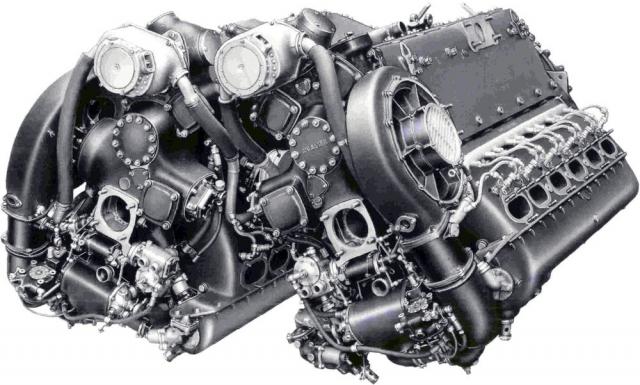
Une caractéristique originale de l'avion était l'utilisation de deux moteurs dans chaque nacelle entraînant une seule hélice. Siegfried Günther, l'ingénieur en chef de Heinkel, utilisa le Daimler-Benz DB 606, qui consistait en deux Daimler-Benz DB 601 couplés ensemble pour entraîner une seule hélice afin de réduire au minimum la traînée.
An unusual feature of the aircraft was the use of twin engines in each nacelle driving a single propeller. Siegfried Günther, chief designer of Heinkel, chose to use the Daimler-Benz DB 606, which consisted of two Daimler-Benz DB 601 engines coupled together to use a common propeller, in order to minimise drag.

L'exigence de cette configuration de moteur fut issue de la détermination du RLM pour que l'He 177 soit capable de bombarder en plongeant.
The insistence of this engine configuration stemmed directly from the RLM's determination that the He 177 should be capable of dive bombing.
 He 177 - Test de vol en piqué - Diving test
He 177 - Test de vol en piqué - Diving test
© Bundesarchiv, Bild 101I-668-7163-14 / Linden / CC-BY-SA
(Cette image est soumise aux droits de Creative Commons Attribution ShareAlike 3.0 Germany License)
(This picture is licensed under Creative Commons Attribution ShareAlike 3.0 Germany License)
 L'utilisation de seulement deux hélices sur un bombardier lourd devait offrir une réduction substantielle de la traînée et une amélioration nette de la manœuvrabilité. Véritablement, les prototypes initaux et les premiers modèles de pré-série du He 177 avaient une vitesse et une manoeuvrabilité comparables à celles de beaucoup de chasseurs lourds de l'époque.
L'utilisation de seulement deux hélices sur un bombardier lourd devait offrir une réduction substantielle de la traînée et une amélioration nette de la manœuvrabilité. Véritablement, les prototypes initaux et les premiers modèles de pré-série du He 177 avaient une vitesse et une manoeuvrabilité comparables à celles de beaucoup de chasseurs lourds de l'époque.
The use of only two propellers on a heavy bomber offered a substantial reduction in drag and a marked improvement in maneuverability. Indeed, the initial prototypes and pre-production models of the He 177 had an airspeed and a manoeuvrability comparable to many heavy fighters of the time.
 Heinkel He 177, 1944
Heinkel He 177, 1944
© Lückel Bundesarchiv Bild 101I-676-7972A-14
(Cette image est soumise aux droits de Creative Commons Attribution ShareAlike 3.0 Germany License)
(This picture is licensed under Creative Commons Attribution ShareAlike 3.0 Germany License)
Le moteur DB 606 a été produit en deux versions A et B, selon le sens de rotation du moteur. Les prototypes de He 177 V1 à V3 ont été équipés de la seule version A, qui tournait en sens inverse des aiguilles d'une montre vu de face, tandis que le prototype V4 et suivants utilisèrent une version A et une version B du DB 606, ou son remplaçant, le DB 610.
The DB 606 engine was produced in A and B versions, according to the engine's rotation. The He 177 V1 through V3 prototypes were equipped with only the A version, which rotated counterclockwise when seen from the front, while the V4 prototype and later used one A and one B version of the DB 606, or its replacement, the DB 610.
 Heinkel He 177 A-3 "6N+DN"- 5./KG 100 - Aalborg, Danemark, début 1944 - Aalborg, Denmark, early 1944.
Heinkel He 177 A-3 "6N+DN"- 5./KG 100 - Aalborg, Danemark, début 1944 - Aalborg, Denmark, early 1944.
Photo : auteur inconnu - author unknown

Heinkel He 177 A-3 (A-5/R2 ?) "6N+DN" WNr 550131 - 5./KG 100
Aalborg, Danemark, début 1944 - Aalborg, Denmark, early 1944.
© Jean-Marie Guillou
Mais le moteur DB 606, à cause de son installation très serrée sur le He 177, entraîna des problèmes considérables, le plus connu étant des feux ou surchauffe moteur en plein vol. C'est ainsi que les équipages le surnommèrent le ‘Luftwaffenfeuerzeug' (le briquet de la Luftwaffe).
But the DB 606 engine, because of its extremely tight installation on the He 177, led to considerable problems, the most common being in flight engine fires and overheating. That's why the crews nicknamed it the Luftwaffenfeuerzeug (Luftwaffe's lighter).
 Heinkel He 177, 1944
Heinkel He 177, 1944
© Blaschka Bundesarchiv Bild 101I-676-7971A-23
(Cette image est soumise aux droits de Creative Commons Attribution ShareAlike 3.0 Germany License)
(This picture is licensed under Creative Commons Attribution ShareAlike 3.0 Germany License)
 Avec les versions suivantes de l'He 177A-3, une nacelle modifiée avec le nouveau moteur Daimler-Benz DB 610 fut utilisé pour essayer de réduire la tendance aux feux moteurs. Ces modifications furent efficace concernant les feux moteur, mais il y eu d'autres problèmes mineurs avec la boîte de transfert entre les deux moteurs et leur hélice.
Avec les versions suivantes de l'He 177A-3, une nacelle modifiée avec le nouveau moteur Daimler-Benz DB 610 fut utilisé pour essayer de réduire la tendance aux feux moteurs. Ces modifications furent efficace concernant les feux moteur, mais il y eu d'autres problèmes mineurs avec la boîte de transfert entre les deux moteurs et leur hélice.
With later versions of the He 177A-3, a modified nacelle with the new engine Daimler-Benz DB 610, was used to reduce tendency for the fire engines. These modifications were successful as far as engine fires were concerned but there were other minor problems with the transfer gearbox between the two engines and their propeller.
 Cockpit He 177 - Photo : auteur inconnu - author unknown
Cockpit He 177 - Photo : auteur inconnu - author unknown
Armement - Armament
 Heinkel He 177 A-1 - MG 81, 7.92 mm + MG/FF 20 mm
Heinkel He 177 A-1 - MG 81, 7.92 mm + MG/FF 20 mm
Photo : auteur inconnu - author unknown Heinkel He 177 - MG 81, 7.92 mm - Photo : auteur inconnu - author unknown
Heinkel He 177 - MG 81, 7.92 mm - Photo : auteur inconnu - author unknown
 Sur la version A-1, l'armement de base se compose d'une mitrailleuse MG 81 (7,9 mm) à l'avant du cockpit, d'un canon MG/FF (20 mm) dans la gondole inférieure avant, d'une mitrailleuse MG 131 (13 mm) en tourelle supérieure (contrôlée à distance) et d'une mitrailleuse de queue.
Sur la version A-1, l'armement de base se compose d'une mitrailleuse MG 81 (7,9 mm) à l'avant du cockpit, d'un canon MG/FF (20 mm) dans la gondole inférieure avant, d'une mitrailleuse MG 131 (13 mm) en tourelle supérieure (contrôlée à distance) et d'une mitrailleuse de queue.
On the A-1 version, the basic armament consists of a machine gun MG 81 (7.9 mm) in the cockpit, a gun MG/FF (20 mm) in the front of the under-nose gondola, a machine gun MG 131 (13 mm) in upper turret (remotely controlled) and a machine gun in the tail.
 Heinkel He 177 - MG 81, 7.92 mm - 1943
Heinkel He 177 - MG 81, 7.92 mm - 1943
© Keiner Bundesarchiv Bild 101I-674-7766-25A
(Cette image est soumise aux droits de Creative Commons Attribution ShareAlike 3.0 Germany License)
(This picture is licensed under Creative Commons Attribution ShareAlike 3.0 Germany License)
Sur la version A1/R1 s'ajoute une mitrailleuse MG 81 en arrière de la gondole ventrale.
On the version A1 / R1, a machine gun MG 81 is added at the back of the under-nose gondola.
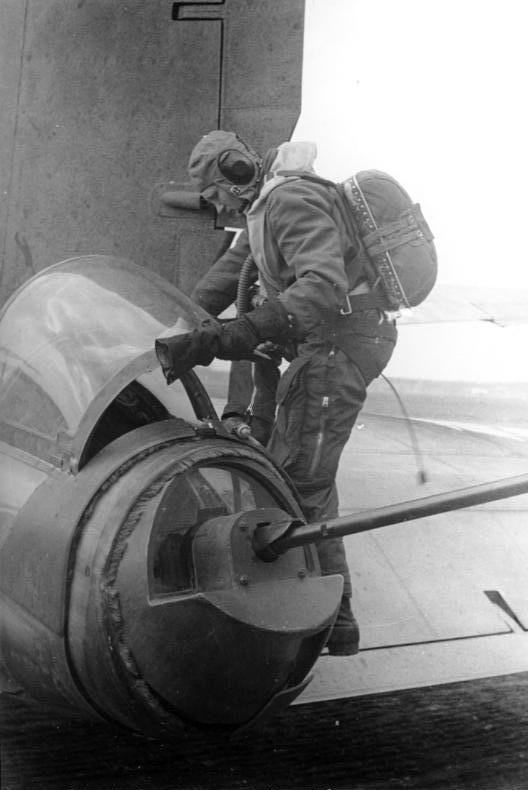
He 177 - 1944 © Bundesarchiv, Bild 101I-668-7164-16A / Linden
(Cette image est soumise aux droits de Creative Commons Attribution ShareAlike 3.0 Germany License)
(This picture is licensed under Creative Commons Attribution ShareAlike 3.0 Germany License)
 He 177 - 1944 © Bundesarchiv, Bild 101I-668-7164-14A / Linden / CC-BY-SA
He 177 - 1944 © Bundesarchiv, Bild 101I-668-7164-14A / Linden / CC-BY-SA
(Cette image est soumise aux droits de Creative Commons Attribution ShareAlike 3.0 Germany License)
(This picture is licensed under Creative Commons Attribution ShareAlike 3.0 Germany License)
Sur les versions R2 et R3 s'ajoute une mitrailleuse MG 131 sous la tourelle inférieure arrière. Sur la version R4, une mitrailleuse similaire est mise à l'arrière de la tourelle ventrale.
On the R2 and R3 versions is added a machine gun MG 131 under the back turret. On the R4 version, a similar gun is located at the back of the under-nose turret.
 He 177 A-5 © Lückel Bundesarchiv Bild 101I-676-7972A-34
He 177 A-5 © Lückel Bundesarchiv Bild 101I-676-7972A-34
(Cette image est soumise aux droits de Creative Commons Attribution ShareAlike 3.0 Germany License)
(This picture is licensed under Creative Commons Attribution ShareAlike 3.0 Germany License)
 L'armement de la version A-3 est renforcé par une tourelle commandée électriquement et armée de deux MG 131. Le A3/R1 a le même armement que les A-1/R2 et R3. Le A-3/R2 est équipé d'un MG 151 à la place du canon de la gondole avant et le poste du mitrailleur de queue est redessiné pour que celui-ci soit assis plutôt qu'allongé.
L'armement de la version A-3 est renforcé par une tourelle commandée électriquement et armée de deux MG 131. Le A3/R1 a le même armement que les A-1/R2 et R3. Le A-3/R2 est équipé d'un MG 151 à la place du canon de la gondole avant et le poste du mitrailleur de queue est redessiné pour que celui-ci soit assis plutôt qu'allongé.
The armament of the A-3 version is reinforced by a turret controlled electrically and equipped with two MG 131. The A3/R1 has the same armament as the A-1/R2 and R3. The A-3/R2 is equipped with a MG 151 instead of the gun of the front gondola and the station of the tail machine gunner is redesigned so that this one sat rather than lengthened.







 Variantes de tourelles - Variants of turrets.
Variantes de tourelles - Variants of turrets.
Photos : auteurs inconnus - authors unknown
 La version A-3/R5 est armée d'un canon BK de 75 mm en gondole. Sur la version A-5/R2, principale version de la série A-5, l'armement est de 1 mitrailleuse MG 81 à l'avant (en haut) et 1 MG 151 (en bas), 2 MG 131 dans la tourelle supérieure avant et 1 dans la supérieure arrière, 1 MG 131 à l'arrière de la gondole ventrale et 1 MG 151 en tourelle de queue.
La version A-3/R5 est armée d'un canon BK de 75 mm en gondole. Sur la version A-5/R2, principale version de la série A-5, l'armement est de 1 mitrailleuse MG 81 à l'avant (en haut) et 1 MG 151 (en bas), 2 MG 131 dans la tourelle supérieure avant et 1 dans la supérieure arrière, 1 MG 131 à l'arrière de la gondole ventrale et 1 MG 151 en tourelle de queue.
The A-3/R5 version is equipped with a 75 mm BK gun in the gondola. On the A-5/R2 version, the major A-5 version, the armament consists of 1 MG 81 machine gun in the front (upper position) and 1 MG 151 (lower position), 2 MG 131 in the upper front turret and 1 in the upper rear one, 1 MG 131 at the rear of the under-nose gondola and 1 MG 151 in the tail turret.
 Heinkel He 177 - 1944 © Bundesarchiv, Bild 101I-676-7970A-23 / Blaschka / CC-BY-SA
Heinkel He 177 - 1944 © Bundesarchiv, Bild 101I-676-7970A-23 / Blaschka / CC-BY-SA
(Cette image est soumise aux droits de Creative Commons Attribution ShareAlike 3.0 Germany License)
(This picture is licensed under Creative Commons Attribution ShareAlike 3.0 Germany License)
 Heinkel He 177 A-3 - Chargement d'une bombe SC 1800 - Loading of a SC 1800 bomb
Heinkel He 177 A-3 - Chargement d'une bombe SC 1800 - Loading of a SC 1800 bomb
Photo : auteur inconnu - author unknown
Versions - Variants
 © Dekker Art Work - Thierry Dekker (http://dekkerartwork.over-blog.com/)
© Dekker Art Work - Thierry Dekker (http://dekkerartwork.over-blog.com/)
He 177 V1-V8
 Heinkel He 177 V1 - Photo : auteur inconnu - author unknown
Heinkel He 177 V1 - Photo : auteur inconnu - author unknown
 Premier prototype construit en 8 exemplaires. Le RLM passe sa commande le 12 novembre 1938. Le V1 (code CB + RP) vole pour la première fois le 20 novembre 1939 à Rostock-Marienehe, piloté par Carl Francke. Le V1 effectuera de nombreux vols d'essai jusqu'au 3 octobre 1941 où il sera détruit à l'atterissage (pilote Schuck).
Premier prototype construit en 8 exemplaires. Le RLM passe sa commande le 12 novembre 1938. Le V1 (code CB + RP) vole pour la première fois le 20 novembre 1939 à Rostock-Marienehe, piloté par Carl Francke. Le V1 effectuera de nombreux vols d'essai jusqu'au 3 octobre 1941 où il sera détruit à l'atterissage (pilote Schuck).
First prototype, 8 prototypes built. The RLM places its order on November 12, 1938. The V1 (code CB + RP) flies for the first time on 20th Novembre, 1939, at Rostock-Marienehe, flown by Carl Francke. The V1 made numerous trial flights until the 3rd October, 1941, when it was destroyed during landing (pilot Schuck).
 Heinkel He 177
Heinkel He 177
Prototype V2 à Rostock-Marienehe - V2 prototype at Rostock-Marienehe.
Photo : auteur inconnu - author unknown
Le V2, codé CB + RQ, a un empennage horizontal modifié par rapport au V1. Il sera détruit le 27 juin 1940 au cours d'un vol d'essai au cours duquel son équipage de 4 hommes sera tué. Le V3 (D-AGIG) est détruit en vol d'essai le 24 avril 1941.
The V2 (code CB + RQ), has a modified horizontal stabilizer compared to the V1. It will be destroyed on June 27th, 1940, during a trial flight (crew of 4 men all killed). The V3 (D-AGIG) is destroyed during a trial flight on April 24th, 1941.
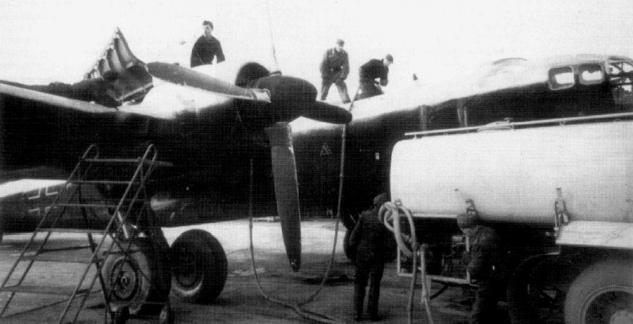 Heinkel He 177 - Photo : auteur inconnu - author unknown
Heinkel He 177 - Photo : auteur inconnu - author unknown
La version V4 fut la première avec des moteurs DB 606 A/B à hélices à rotation opposée, comme ensuite tous les avions de série. Il est détruit, son moteur prenant feu, le 8 juin 1941.
The V4 aircraft first to use opposite-rotation propellers with DB 606 A/B engines, as all later production series aircraft would. It was destroyed, due to an engine fire, on June the 8th, 1941.
 Heinkel He 177 - Prototype V5 en 1942 ou 1943 - Prototype V5 in 1942 or 1943
Heinkel He 177 - Prototype V5 en 1942 ou 1943 - Prototype V5 in 1942 or 1943
© U.S. Navy (domaine public - public domain)
Le V5 retourne en usine en décembre 1940 suite à des problèmes de freins (son poids est devenu trop important). Le V6 (code BC+BP) vole le 18 décembre 1940. Il subit divers accidents en 1942 et sera détruit le 28 juin 1943, comme avion d'essais au IV./KG 40. Le V7 sert à des essais d'armement puis est affecté au IV./KG 40. Le V8 est utilisé pour des essais d'hélice et de volets.
The V5 returns in factory in Decmber, 1940, for braking problems (its weight has become too important). The V6 (code BC+BP) flies for the time on December 1940. It will have several accidents in 1942 and will be destroyed on June the 28th, 1943, as training aircraft in the IV./KG 40. The V7 is used for guns trials and is affected to the IV./KG 40. The V8 is used for propeller and flaps trials.

Heinkel He 177 - Prototype V7
© Bert Hartmann LuftArchiv.de
 Heinkel He 177 - Prototype V8
Heinkel He 177 - Prototype V8
Photo : auteur inconnu - author unknown
He 177 A-0
Pre-série de 35 modèles construits.
Pre-production series, 35 built.
 Heinkel He 177 A-0 "DL+AP" (W.Nr. 000016)
Heinkel He 177 A-0 "DL+AP" (W.Nr. 000016)
1er exemplaire de la série A-0. Détruit au décollage le 8 juillet 1941
1st unit of A-0 series. Destroyed during take-off on July 8th, 1941.
Photo : auteur inconnu - author unknown

 Heinkel He 177 A-0 - Photo : auteur inconnu - author unknown
Heinkel He 177 A-0 - Photo : auteur inconnu - author unknown
 He 177 A-1
He 177 A-1
Première série produite (130 exemplaires).
First production series (130 built).
 Heinkel He 177 A-1 "VE+UN" (W.Nr.15214), Erprobungsstaffel 177 - Photo : auteur inconnu - author unknown
Heinkel He 177 A-1 "VE+UN" (W.Nr.15214), Erprobungsstaffel 177 - Photo : auteur inconnu - author unknown
He 177 A-1/R1
Première version avec tourelle dorsale commandée à distance.
First version with remotely fired forward dorsal turret.
He 177 A-1/U2
Chasseur lourd Grosszerstörer avec canon double MK 101 de 30mm en position basse sous le nez, douze conversions.
Grosszerstörer heavy fighter with twin MK 101 30mm autocannon in lower nose mount, twelve conversions.
 Heinkel He 177 A-1/U2
Heinkel He 177 A-1/U2
Photos : auteur inconnu - author unknown
 He 177 A-1 - I./KG 50 - Fernkampfgruppe 2
He 177 A-1 - I./KG 50 - Fernkampfgruppe 2
Equipé d'un canon Mk 101, front de l'Est, janvier 1943 - Fitted with a Mk 101 gun, Eastern Front, January 1943.
artiste inconnu - artist unknown
He 177 A-2
Version proposée pressurisée à quatre hommes avec armement défensif réduit (six MG 81 et une simple MG 131).
Proposed four-man pressurized variant with reduced defensive armament (six MG 81 and single MG 131 guns).

Heinkel He 177A-3 - © Bert Hartmann LuftArchiv.de
Seconde production en série de 170 examplaires. Motorisé par le DB 610 à partir du seizième avion.
Second production series, 170 built. Sixteenth and subsequent aircraft powered by DB 610 engines.

He 177 A-3
Unité inconnue, début 1944 - Unit unknown, early 1944.
© Dekker Art Work - Thierry Dekker ( http://dekkerartwork.over-blog.com/) He 177 A-3 - Magdeburg
He 177 A-3 - Magdeburg
Début 1944. Appareil d'entraînement - Early 1944. Training aircraft.
© Dekker Art Work - Thierry Dekker ( http://dekkerartwork.over-blog.com/)
 Heinkel He 177 A-3 "TM+IU" WNr. 2236 - Essai d'un réservoir auxiliaire- Test of an auxiliary tank.
Heinkel He 177 A-3 "TM+IU" WNr. 2236 - Essai d'un réservoir auxiliaire- Test of an auxiliary tank.
Photo : auteur inconnu - author unknown
 He 177 A-3/R1
He 177 A-3/R1
Motorisé par deux moteurs DB 606 A/B à piston.
Powered by two DB 606A/B piston engines.

Heinkel He 177A-3/R1 "6N+SK" 2./ KG 100, Châteaudun (France), mars/March 1944.
© Srecko Bradic - www.sreckobradic.com

Heinkel He 177A-3/R1 "6N+SK" 2./ KG 100, Rheine (Westphalie - Westphalia), janvier/January 1944.
© Jean-Marie Guillou
He 177 A-3/R2
Armement defensive modifié - MG 151/20 installé dans la queue.
Modified defensive armament - MG 151/20 installed in tail position.

He 177 A-3/R2 - 2./KG 4, Lechfeld
Photo : source inconnue - source unknown

He 177 A-3/R-2 © Pierre-André Tilley
 Heinkel He 177A-3/R2 "ND+SK" (W. Nr. 135014) - 2./KG 100, Châteaudun (France)
Heinkel He 177A-3/R2 "ND+SK" (W. Nr. 135014) - 2./KG 100, Châteaudun (France)
février ou mars1944 - February or March 1944
© Linden Bundesarchiv Bild 101I-668-7161-31A
(Cette image est soumise aux droits de Creative Commons Attribution ShareAlike 3.0 Germany License)
(This picture is licensed under Creative Commons Attribution ShareAlike 3.0 Germany License)
Une autre source indique que le He 177 ci-dessus est un He 177 A-5 du 2/KG 100 immatriculé "6N+SK" (comme ci-dessous) et non un A-3 "ND+SK".
Another source indicates that the He 177 here above is a He 177 A-5 from 2/KG 100 coded "6N+SK" (like here below)and not an A-3 "ND+SK".
He 177 A-3/R3
Version anti navire équipée de Henschel Hs 293.
Anti-shipping version equipped with Henschel Hs 293.
 Heinkel He 177 A3/R3
Heinkel He 177 A3/R3
Photos : auteur inconnu - author unknown
 Henschel Hs 293 - Photo : auteur inconnu - author unknown
Henschel Hs 293 - Photo : auteur inconnu - author unknown
 He 177 A-3/R4
He 177 A-3/R4
Equipé de missile FuG 203 Kehl III.
Fitted with FuG 203 Kehl III missile.
 FuG 203 - Photo : auteur inconnu - author unknown
FuG 203 - Photo : auteur inconnu - author unknown
He 177 A-3/R5
Version Grosszerstörer armée d'un canon Bordkanone BK 7.7 75 mm dans la gondole ventrale (resté à l'état de projet).
Grosszerstörer version armed with Bordkanone BK 7.5 75 mm gun in ventral gondola, (project only).
He 177 A-3/R7
Version bombardier torpilleur abandonée en faveur du He 177 A-5 (trois exemplaires construits).
Torpedo bomber version abandoned in favor of the He 177 A-5 (three built).
He 177 A-4
Projet de version pressurisée de haute altitude transformée en Heinkel He 274.
Proposed high altitude pressurised version later developed into the Heinkel He 274.
He 177 A-5
 Heinkel He 177 A-5
Heinkel He 177 A-5
Ce modèle sera modifié en He 277 en été 1944.
This unit was modified to become He 277 in summer, 1944.
Photo : auteur inconnu - author unknown
Principale version produite avec charge de bombes extérieure maximum (826 exemplaires).
Main production version with increased maximum external bombload (826 built).
 He 177 A-5 - 2./KG 4.
He 177 A-5 - 2./KG 4.
Capturé par la Résistance Française avant le débarqument. Après avoir volé aux couleurs françaises, il rejoint l'Angleterre où il sera ferraillé en 1946.
Captured by the French Resistance before D-Day. After flying in French markings for a short time; it went to England where it was tested before being scrapped in 1946.
Artiste inconnu - artist unknown - source : http://wp.scn.ru/en/ww2/b/446
 He 177 A-5/R1
He 177 A-5/R1
Version améliorée pour Hs 293 et bombes guides Fritz X.
Version optimized for Hs 293 and Fritz X guided bombs.
He 177 A-5/R2

 Heinkel He 177 A-5/R2 (R6 ?) "KM+UD" (W.Nr. 550054) - 6./KG 100 (KG 40 ?)
Heinkel He 177 A-5/R2 (R6 ?) "KM+UD" (W.Nr. 550054) - 6./KG 100 (KG 40 ?)
Photos & artwork : auteur inconnu - author unknown He 177 A-5/R2 - Stab/KG 1 - Prusse Orientale, été 1944 - East Prussia, Summer 1944.
He 177 A-5/R2 - Stab/KG 1 - Prusse Orientale, été 1944 - East Prussia, Summer 1944.
Artiste inconnu - artist unknown - source : http://wp.scn.ru/en/ww2/b/446
He 177 A-5/R6
 He 177 A-5/R6 - II/KG 40 - France, printemps 1944 - France, Spring 1944.
He 177 A-5/R6 - II/KG 40 - France, printemps 1944 - France, Spring 1944.
Artiste inconnu - artist unknown - source : http://wp.scn.ru/en/ww2/b/446
 He 177 A-5/R4
He 177 A-5/R4
Version avec soute à bombes simplifiée équipée du mécanisme Kehl pour bombes guidées.
Simplified bomb rack installation, equipped with Kehl control gear for guided ordnance.
He 177 A-5/R5
Double MG 131 contrôlée à distance à l'arrière de la gondole ventrale (resté à l'état de projet)
Twin MG 131 remotely fired guns in rear of ventral gondola (project only).
He 177 A-5 Pulkzerstörer
Variante anti-bombardier, armée de 33 roquettes à rotation stabilisée, montées obliquement dans le fuselage à la place des soutes à bombes et réservoirs auxiliaires. Trois exemplaires livrés en juin 1944 pour essais.
Anti-bomber variant, armed with 33 spin-stabilised rockets obliquely mounted in fuselage, supplanting bomb bays and auxiliary fuel tanks. Three examples delivered in June 1944 for trials.
He 177 A-5 Stalingradtyp
Version armée du canon BK 7.5 de 75 mm pour des missions d'attaques au sol et de DCA.
Variant armed with BK 7.5 75 mm gun for flak and ground attack missions
He 177 A-5/R6
Capacité de soute à bombe réduite.
Reduced bomb bay capacity.
He 177 A-5/R7
Etude de cockpit pressurise, avec armement réduit de la version A-2.
Pressurised cockpit study only, with A-2 version's reduced armament.
He 177 A-6
Bombardier longue portée de haute altitude avec charge de bombes et armement augmentés. Six modèles fabriqués sous le nom He 177 A-6/R1. Cette version avait également une tourelle de queue et pouvait emporter des missiles Henschel 293.
Long range, high altitude pressurised bomber with increased bomb load and defensive armament. Six built as the He-177 A-6/R1. This version also had a tail turret and the capability to carry Henschel 293 missiles.
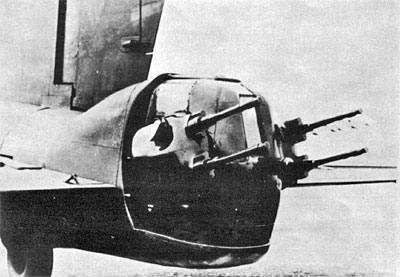 Heinkel He 177 A-6 - Tourelle arrière - Rear turret.
Heinkel He 177 A-6 - Tourelle arrière - Rear turret.
Photo : auteur inconnu - author unknown
 He 177 A-7
He 177 A-7
Conversion de six fuselages de He 177A-5 supposés recevoir une aile de 36 m et avec des moteurs DB 610 au lieu des DB 613 prévus.
Conversion of six He 177A-5 airframes which were intended to have a 36 m wing, and with DB 610 engines instead of the intended 3,600 hp DB 613 engines.
"He 177 B"
Appellation de couverture assignée initialement par Heinkel au Heinkel He 277 (quatre moteurs), pour dissimuler le travail de recherche au Ministère de l'Air du Reich et particulièrement à Hermann Goering et à l'OKL.
Cover designation initially assigned by Heinkel to Heinkel He 277 (four engines), to conceal development work from Reich Air Ministry, particularly from Hermann Goering, and OKL.
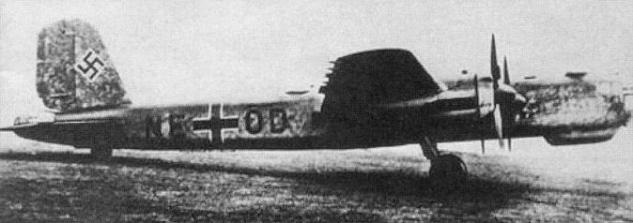 Heinkel He 177 B-5 "NE+OD"
Heinkel He 177 B-5 "NE+OD"
© Bert Hartmann LuftArchiv.de  Heinkel He 177 A-5 + Gotha Go 242
Heinkel He 177 A-5 + Gotha Go 242
Rare (et mauvaise) photo d'un He 177 tractant un Go 242.
Unique (and bad) picture of a He 177 towing a Go 242.
Photo : auteur inconnu - author unknown
Source : Wikipedia
Production jusqu'au 30 novembre 1944. Production till 30 November, 1944.

EHF : Ernst Heinkel Flugzeugwerke - HWO : Heinkel Werke Oranienburg - ArB : Arado Brandenburg
"Kehl" : nom de code des unités de commande radio intégrées pour les bombes Hs 293 et Fritz X
: code name of integrated radio control units for bombs Hs 293 and Fritz X .
(1) 01/1942 > 01/1943
(2) vieux bâtiment - old facility - 11/1942 > 07/1943
(3) nouveau bâtiment - new facility - 08/1943 > 06/1944
(4) 08/1943 > 12/1943
(5) 11/1943 > 01/1944
(6) 06/1944 > 07/1944
(7) 12/1943 > 08/1944
Source : Smith/Creek

EHF : Ernst Heinkel Flugzeugwerke - HWO : Heinkel Werke Oranienburg - ArB : Arado Brandenburg
Source : Griehl/Dressel

(1) 1 x A-0, 1 x A-3, 2 x A-5
reconstruits en prototypes He 177B depuis avant décembre 1943 à juillet 1944
rebuilt as He 177B prototypes from before December 1943 to July 1944

Heinkel He 177 - Source inconnue - Unknown source
 La complexité du programme du He 177 entraîna la fabrication de npmbreux prototypes.
La complexité du programme du He 177 entraîna la fabrication de npmbreux prototypes.
The complexity of the He 177's program led to the manufacturing of numerous prototypes.
 Heinkel He 177 "KM+UU" - artiste inconnu - artist unknown
Heinkel He 177 "KM+UU" - artiste inconnu - artist unknown
Premiers prototypes. First prototypes
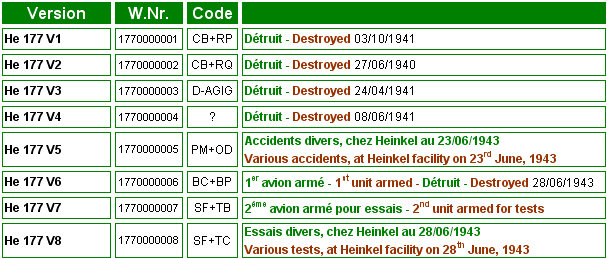
 Heinkel He 177 V1 "CB+RP" - Photo : auteur inconnu - author unknown
Heinkel He 177 V1 "CB+RP" - Photo : auteur inconnu - author unknown
 Prototypes série A. A Series prototypes
Prototypes série A. A Series prototypes

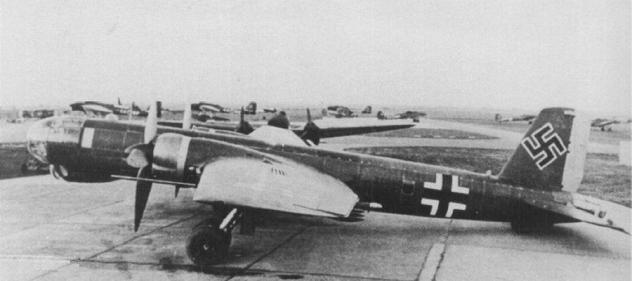 Heinkel He 177 V2, Marienehe
Heinkel He 177 V2, Marienehe
Le code "CB+RQ" n'est pas encore peint. The "CB+RQ" code is not yet painted
Photo : auteur inconnu - author unknown
 Heinkel He 177 V7
Heinkel He 177 V7
Visite de Hermann Göring en France - Hermann Göring's visit in France
Photo : auteur inconnu - author unknown


Heinkel He 177 A-1 V-12 "GI+BL" WNr 15151
photo source inconnue - source unknown - profil artiste inconnu - profile artist unknown
 Heinkel He 177 V8 "SF+TC" - Photo : auteur inconnu - author unknown
Heinkel He 177 V8 "SF+TC" - Photo : auteur inconnu - author unknown
 Heinkel He 177 V9 "GA+QQ" - Photo : auteur inconnu - author unknown
Heinkel He 177 V9 "GA+QQ" - Photo : auteur inconnu - author unknown

 Heinkel He 177 A-5 V31 "TM+IF"
Heinkel He 177 A-5 V31 "TM+IF"
Essai de largage de torpille L10 à Gotenhafen (Pologne)
L10 torpedo dropping test at Gotenhafen (Poland)
Photo : auteur inconnu - author unknown

 Heinkel He 177 A-5 V38 "KM+TB" - Photo : auteur inconnu - author unknown
Heinkel He 177 A-5 V38 "KM+TB" - Photo : auteur inconnu - author unknown
